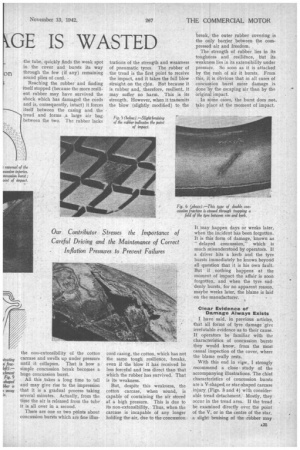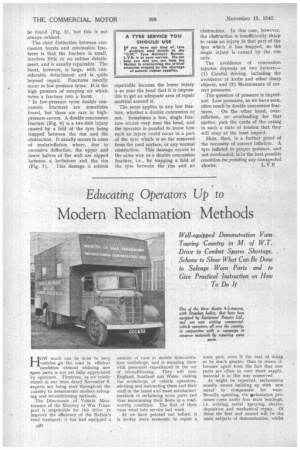HOW TYRE MU GE IS WASTED
Page 26

Page 27

Page 28

If you've noticed an error in this article please click here to report it so we can fix it.
WE know that a tyre consists of two rather fragile vegetable substances — rubber a n d cotton. Despite their fragile nature, these materials are capable of withstanding normal usage for many thousands of miles.
Normal usage, however, does not include severe impacts against obstructions, such as kerbstones, brick-ends, etc. A tyre is designed to roll through life, not smash its way through. It is capable of withstanding, within limits, the impacts suffered wnile travelling along bumpy roads, but it will not survive severe • concussion against larger objects. We have seen that shock absorption through deflection is the primary duty of the pneuntatic tyre, but, jfist as the amount of deflection must be con
• trolled if the tire is to give normal service, so must the amount of shock also be controlled so far as is possible. It is probable that almost complete shock absorption Could be obtained by running a large tyre at a ridiculously low pressure, but the effect on the tyre, both from excessive deflec
• tion and from the increased susceptibility of the casing to concussion damage, renders the scheme impracticable.
Tyre Deflection Is Really a Compromise Tyre deflection is, therefore, a compromise between the practical emits of shock absorption on the one hand and casing life on the other. In other words, the air pressure must be sufficient to support the casing whilst allowing a little deflection for the absorption of normal road shocks.
Abnormal shocks, caused by sharp impacts against unyielding objects, are the cause of innumerable tyre failures. In most cases they are caused by careless driving and are, therefore, easily avoidable.
A tyre is built up in a series of A24 plies•ot cord material, each succeeding ply being slightly bigger than its predecessor because, obviously, as one ply succeeds another a greater area has to be covered. Thus, when viewing the tyre in transverse section, the inside plies are seen to be smaller than the outside plies. This is the tyre's natural shape, but under load and in response to normal deflection there is a slight flattening at the point of road contact.
Now, if the tyre, while travelling at speed, is forced into violent contact with a hard object, it will deflect abnormally at the point of impact. In the small area which receives the blow the plies of cord will be pressed inwards to a considerable extent. This means that the natural curve on the inside of the casing will be momentarily reversed. The inner plies, instead Of being on the inner side of the tyre's natural curve, will be forced, in one small area, on to the outside of the curve. This effect can be seen in Fig. 1.
The stress is terrific, and is far beyond the limits of normal .deflection. The tread rubber and the outer plies of cord are compressed and are, consequently, not in much danger, but the smaller inner plies are stretched around them, because they are now on the outside of the feversed curve. As a result, they are stressed to their uttermost limit and will probably break.
This is how the typical concussion break (Fig. 2) is caused. . But, on giant tyres run at high pressures it seldom stops there. The breaking of the inner plies of cord causes a break in the tube. This suddenly releases a big volume of air stored at a very high pressure. Irresistibly, the air rushes out through the hole in the tube, quickly finds the weak spot in the cover and bursts its way
on through the few (if any) remaining sound plies of cord. •
Reaching the rubber and finding itself stopped (because the more resilient rubber may have survived the shock which has damaged the cords and is, consequently, intact) it forces itself between the casing and the tread and forms a large air bag between the two. The rubber lacks the non-extensibility of the cotton carcase and swells up under pressure until it collapses. That is how a simple concussion break becomes a huge concussion burst.
All this takes a long time to tell and may give rise to the impression that it is a gradual process taking several minutes. Actually, from the time the air is released from the tube it is all over in a second.
There are one or two points about concussion bursts which are fine illus trations of the strength and weakness of pneumatic tyres. The rubber of the tread is the first point to receive the impact, and it takes the full blow straight on the chin. But because it is rubber and, therefore, resilient, it may suffer no harm. This is its strength. However, when it transmits the blow (slightly modified) to the
cord casing, the cotton, which has not the same tough resilience, breaks, even if the blow it has received be less forceful and less direct than that which the rubber has survived. That is its weakness.
But, despite this weakness, the cotton carcase, when sound, is capable of containing the air stored at a high pressure. This is due to its non-extensibility. Thus, when the carcase is incapable of any longer holding the air, due to the concussion break, the outer rubber covering is the only barrier between the compressed air and freedom.
The strength of rubber lies in its toughress and resilience, but its weakness lies in its extensibility under pressure. So soon as it is attacked by the rush of air it bursts. From this, i is obvious that in all cases of concu ion burst more damage is done r the escaping air than by the origina1 impact.
In siiie cases, the burst does not. take p ace at the moment of impact.
It may happen days or weeks later, when the incident has been forgotten. It is this form of damage, known as " delayed concussion," which is much misunderstood by operators. If a driver hits a kerb and the tyre bursts immediately he knows beyond all question that it is his own fault. But if nothing happens at the moment of impact the affair is soon forgotten, and when the tyre suddenly bursts, for no apparent reason, maybe weeks later, the blame is laid on the manufacturer.
Clear Evidence of Damage Always Exists I have said, in previous articles, that all forms of tyre damage give irrefutable evidence as to their cause. If operators be familiar with the characteristics of concussion bursts they would know, from the most casual inspection of the cover, where the blame really rests.
With this end in vipw, I strongly recommend a close , study of the accompanying illustrations. The chief characteristics of concussion bursts are a V-shaped or star-shaped carcase injury (Figs. 3 and 4) with considerable tread detachment. Mostly, they occur in the tread area. If the tread be examined directly over the point of the V, or in the centre of the star, a slight bruising of the riibber may
be found (Fig. 5), but this is not always evident.
The chief distinction between concussion bursts and concussion fractures is that the fracture is small, involves little or no rubber detachment, and is usually repairable. The burst, however, is large, with considerable detachment and is quite beyond repair. Fractures usually occur in low-pressure tyres. It is the high pressure of escaping air which turns a fracture into a burst.
• In low-pressure tyres double concussion fractures are sometimes found, but these are rare in highpressure covers. A double concussion fracture (Fig. 6) is a two-fold injury caused by a fold of the tyre being trapped between the rim and the obstruction. It usually occurs in cases of rinderint3ation where, due to excessive deflection, the upper and lower halves of the wall are nipped between a kerbstone and the rim (Fig. 7). This damage is seldom repairable because the lower injury is so near the bead that it is impossible to get an adequate area of repair material around it.
The same applies to any low fracture, whether a double concussion or not. Sometimes a low, single fracture occurs very near the bead, and the operator is puzzled to know how such an injury could occur in a part of the tyre which is so far removed from the road surface, or any normal obstruction. This damage occurs in the same way as a double concussion fracture, i.e., by trapping a fold of the tyre between the rim and an obstruction. In this case, however, the obstruction is insufficiently sharp to cause an injury in that part of the tyre which it has trapped, so the single injury is caused by the rim only.
The avoidance of concussion injuries depends .on two factors:— (1) Careful driving, including the avoidance of kerbs and other sharp objects, and (2) Maintenance of correct pressures.
The question of pressure is important: Low pressures, as we have seen, often result in double concussion frac
tures. On the other hand, overinflation, or overloading for that matter, puts the cords of the casing in such a state of tension that they will snap at the least impact.
Here, then, is a further proof of the necessity of correct inflation. A tyre inflated to proper pressure, and not overloaded, is in the best possible condition for „resisting any unexpected
shocks. L.V.E




















































